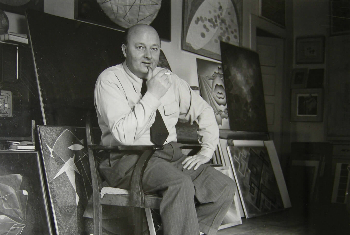Oskar Fischinger
Filmmaker
Oskar Fischinger was born in 1900 in Gelnhausen, Germany. Around 1920 in Frankfurt, he met Dr. Bernhard Diebold at a literary club; seeing Fischinger's abstract scroll sketches, Diebold urged him to take up abstract filmmaking. Fischinger soon resigned his engineer's job and moved to Munich to become a full-time filmmaker. Oskar pursued experiments with drawn synthetic sound and collaborated with Bela Gaspar on a three-color film process, GasparColor, which allowed him in 1933 to complete his first color film Kreise. Fischinger's subsequent color films Muratti Marches On and Composition in Blue gained so much critical and popular acclaim that Paramount offered him a contract, and in February 1936 he set sail for Hollywood never to return to Germany.
Fischinger found it extremely difficult to work in studio situations, enduring episodes at Paramount (1936), MGM (1937), and Disney (1938-9). His frustration at not being able to produce independent film led him to take up oil painting, and he came under the patronage of Hilla Rebay, curator of the Solomon Guggenheim Foundation, who extended several grants to him during the difficult war years. For the last twenty years of his life, Fischinger had to content himself with unfinished projects, with his paintings and with a home light-show instrument, the Lumigraph. After some years of relative ill health, he died on January 31, 1967.
Dr. William Moritz
© www.oskarfischinger.org
Update: 18 October 2016
